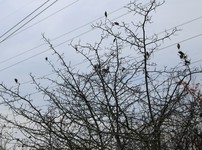News
 |
|
Caterpillars overwinter in silken nests on branch tips. Prune out and destroy nests now to prevent human health problems in spring and summer. |
Now is the time to remove browntail caterpillars
from trees on school grounds. Browntail caterpillars cause a poison ivy-like
rash and they are impacting a broad swath of Maine. Contact with this
caterpillar’s hairs can cause severe reactions for some individuals.
Browntail caterpillars spend the winter webbed in silken-wrapped
leaves on the tips of branches of oak and apple trees. NOW is the time to look
for the bright white silk tying a few leaves to the TIPS of your apple and
other fruit trees and oak tree branches. If you see a web CLIP IT OUT and
destroy the web by dropping it in a bucket of soapy water and soaking it
overnight, do not just leave it on the ground. The caterpillars are ready to go
once warmer weather arrives, so do this task as soon as possible!
Browntail caterpillar webs can be found regularly in Maine from
the New Hampshire border to Deer Isle, and inland to Raymond, Turner, Rome,
Smithfield, Burnham and Eddington. They are worst along the coast from Falmouth
to Bristol and up the Kennebec River to Richmond. In 2017, outlying patches of
defoliation were found in the towns of Belgrade, Burnham, Eddington, Liberty,
Lincolnville, Turner and Whitefield. The moths have been seen all the way west
to Kingfield, north to Ashland and east to Topsfield on the New Brunswick
border.
As we all have heard, “an ounce of prevention is worth a pound of
cure.” People have known that to be true of browntail for more than 100 years.
Learn how to recognize browntail moth webs by visiting the websites below, then
go out and check your trees for their presence. If you find them and can reach
them, clip and destroy them. If you can’t reach them and plan to treat
them, now is the time to line up professional help for this spring
If you think you’ve found webs, but are not sure, contact the
forest service for help http://www.maine.gov/dacf/mfs/forest_health/tree_ailment.html.
The recorded webinar and accompanying slides for Maine schools dealing
with this itchy pest is at www.maine.gov/schoolipm
(click on ‘Pest Solutions’).
Background information, a video showing how to clip the webs, a
list of arborists who could prune webs out of your reach and a list of licensed
pesticide applicators that can treat the webs can be found at: http://www.maine.gov/dacf/mfs/forest_health/invasive_threats/browntail_moth_info.htm
For More Information: Contact the Maine Forest Service (207) 827-1813 or your local University
of Maine Cooperative Extension Office.
 No, you don't need to travel to Florida for our training! With a full schedule of workshops you can get in your IPM training without leaving the state! Registration is open for the free IPM workshops in April and June in Kittery, Madison, Sullivan and Waterville.
Or stay home and get practical information you can use today by watching a webinar. Although it still seems wintry, disease-carrying mosquitoes can breed in snowmelt pools and catchbasins. Learn what you can do to manage and prevent mosquitoes with this upcoming webinar: Integrated Mosquito Management in an Urban Environment, Tuesday, March 20, 2018 | 2:00 – 3:00 p.m. ET. Register HERE.
Or watch a recorded webinar anytime for on-demand training. Find links to many excellent webinars and videos at maine.gov/schoolipm.
|
 Going to the National School Nurse Conference in Baltimore? Look for us at the Northeast School IPM/EPA booth! We'll be giving out tick removal tools and other goodies!
Can't make it to Baltimore? We'll be giving out tick 'spoons' be at the Maine Summer School Nurse Institute at Bates College too!
Find resources to help you address health-impacting pests at www.maine.gov/schoolipm.
|
Questions/Comments? Contact us!
Email: kathy.murray@maine.gov
Phone: 207-287-7616
Get this from a friend? Subscribe Now! Or visit maine.gov/schoolipm to subscribe.
|